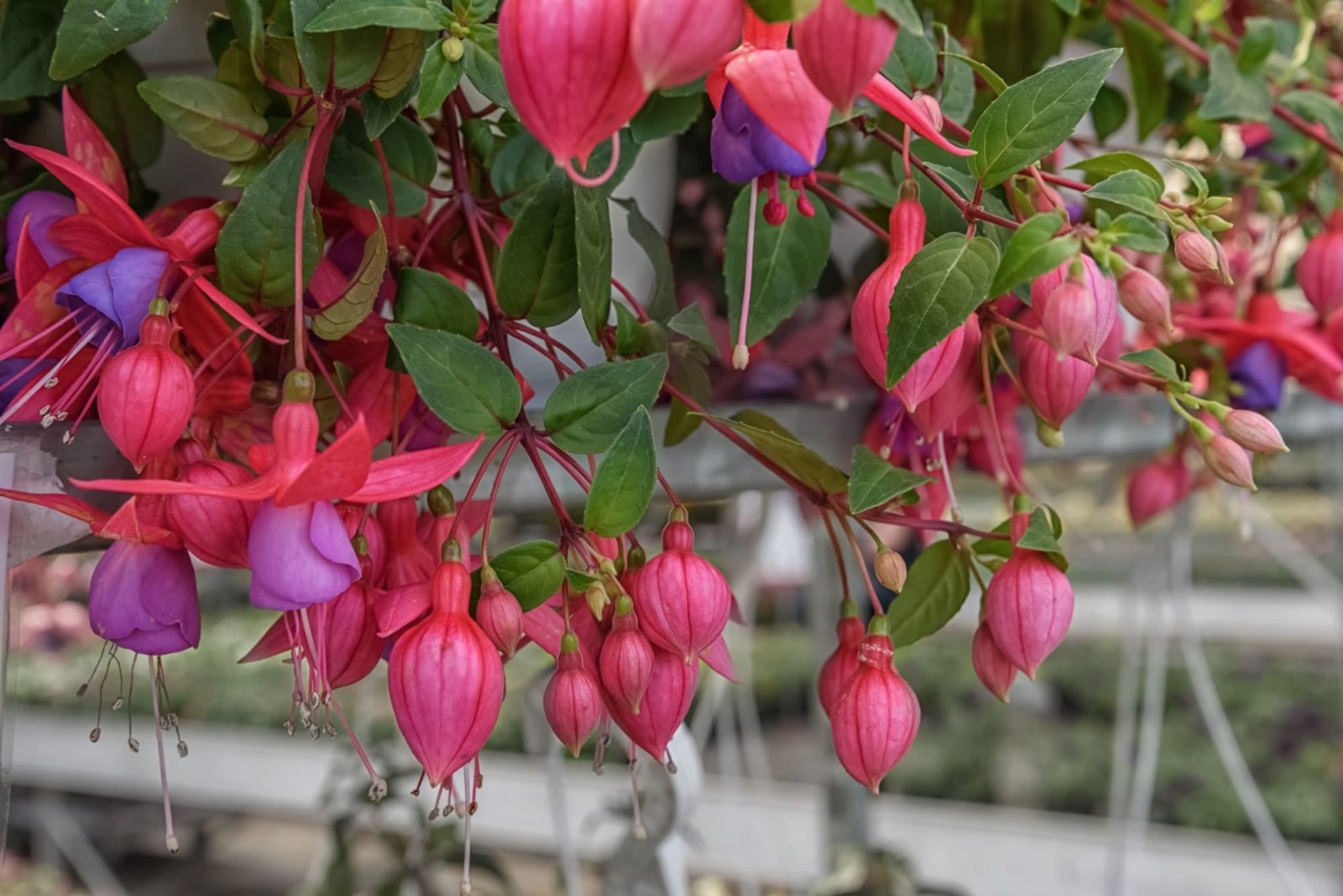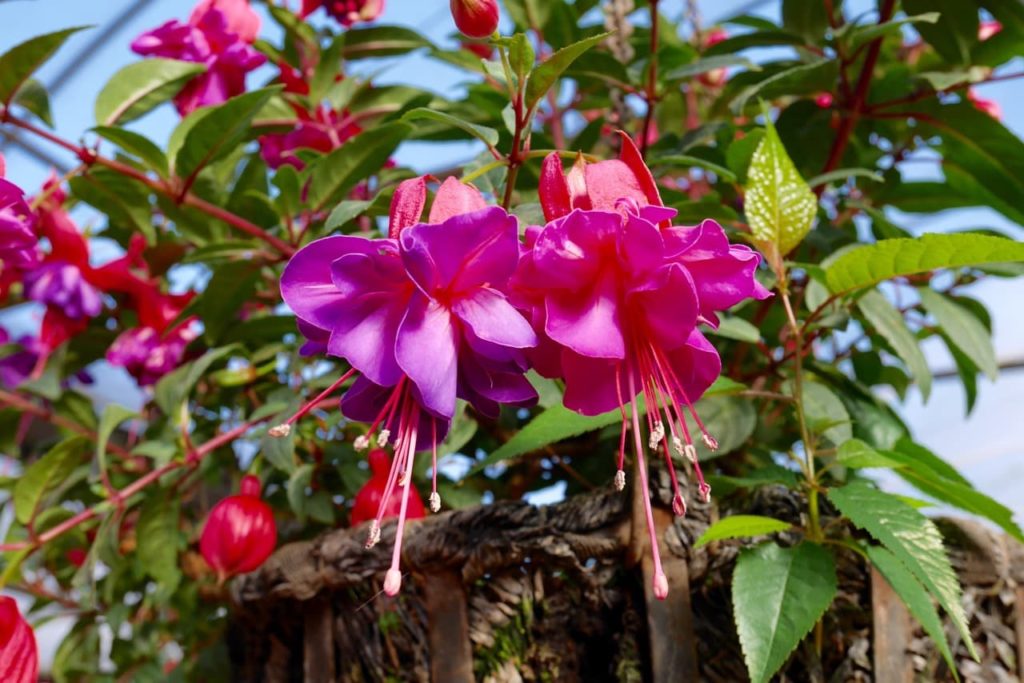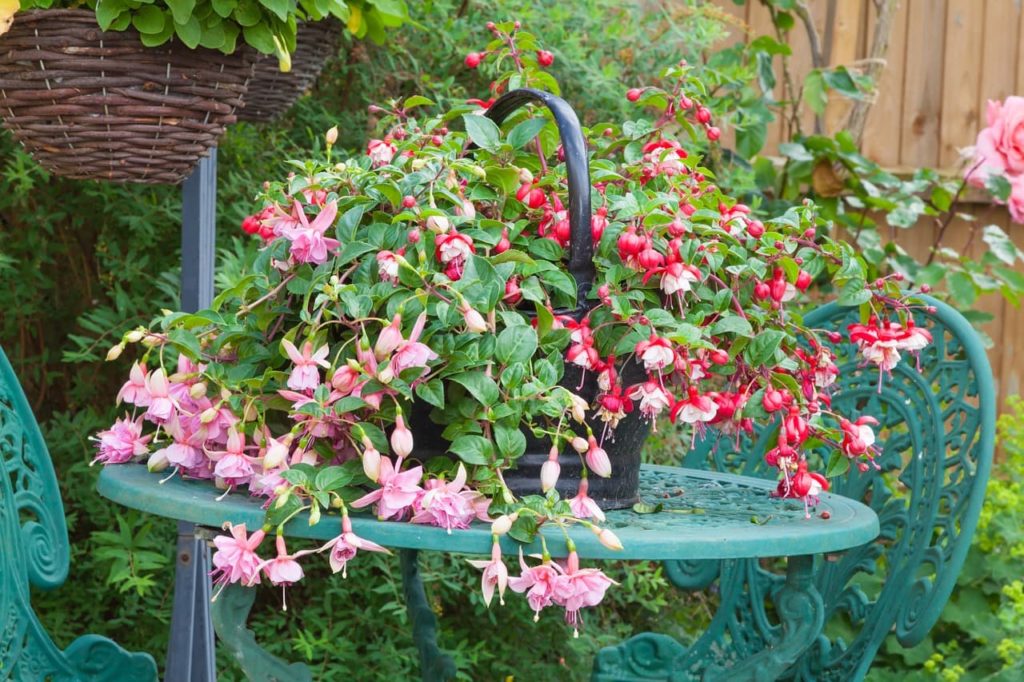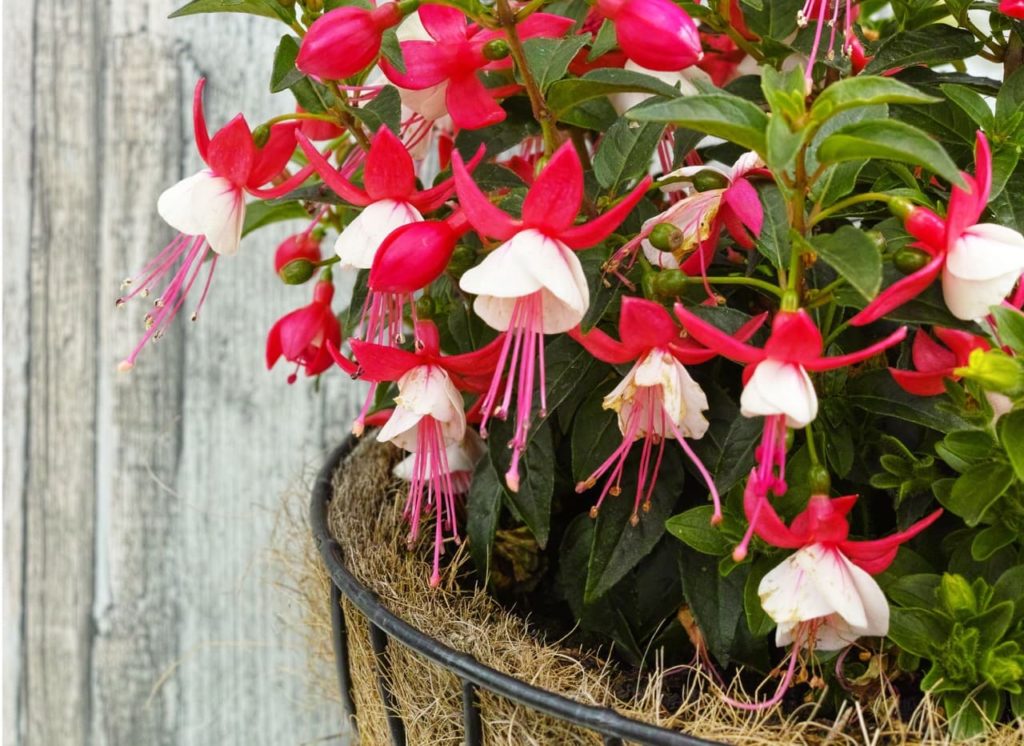Fuchsia Growers’ 7 Tips For Growing Vertically With Hanging Baskets

SHRUBS > FUCHSIA > HANGING-BASKETS

Elizabeth is a Permaculture Garden Designer, Sustainability Consultant and Professional Writer, working as an advocate for positive change. She graduated from the University of St. Andrews with an MA in English and Philosophy and obtained a Diploma in Applied Permaculture Design from the Permaculture Association.
Reviewed By COLIN SKELLY

Colin is a Horticulturist and Horticultural Consultant with experience in a range of practical and managerial roles across heritage, commercial and public horticulture. He holds the Royal Horticultural Society’s Master of Horticulture award and has a particular interest in horticultural ecology and naturalistic planting for habitat and climate resilience.
Contributions From GAIL BARBER

Gail Barber is the Secretary of the Sutton Coldfield Fuchsia & Gardening Guild with experience of more than 50 years in the garden. Gail even has a cultivar of Fuchsia named after her.

Terry is a member of the West Yorkshire Fuchsia & Pot Plant Society and has been growing fuchsias for a few years. He developed his passion for these plants over lockdown and in 2022, entered 5 of the 7 national fuchsia flower shows - including a 2nd place finish at the BFS National Championships.
IN THIS GUIDE
FUCHSIA GUIDES
Container Growing
Hanging Baskets
Hardy
Overwintering
Problems
Propagation
Pruning
Sowing
Varieties
Fuchsias are attractive flowering shrubs that vary greatly in hardiness.
There are hardy fuchsias that can grow outside year-round and more tender types that will need to be overwintered indoors or under cover.
These attractive plants are much admired for their charming, dangling, bell-shaped flowers that can last all summer long and come in a range of hues.
They mostly come from South and Central America.1Fuchsia | San Diego Zoo Animals & Plants. (n.d.-b). https://animals.sandiegozoo.org/plants/fuchsia

Interestingly, the flowers and the berries are edible too, so these are potentially productive and useful plants as well as just ornamental ones.2Fuchsia magellanica. (n.d.). PFAF Plant Database. Retrieved April 12, 2023, from https://pfaf.org/user/Plant.aspx?LatinName=Fuchsia+magellanica
Fuchsias can be grown in the ground or in containers and with tender types in particular, the latter is the better option.
However, you might be wondering whether you can use specific types of containers and whether you can grow fuchsias in hanging baskets.
| Difficulty | Easy |
| Equipment Required | Hanging container, fuchsia plant(s), potting compost, fertiliser, hand trowel, watering can |
Fuchsias can indeed be grown in hanging baskets, though some varieties are better suited to cultivation in this type of container than others.
These are very versatile plants and there are varieties that have a number of different growth habits and vary dramatically in size and spread.
Growing fuchsias in hanging baskets can allow you to take advantage of their long-lasting floral displays to brighten up a wall or fence.
Using hanging baskets and other hanging containers can be beneficial because it can allow you to think vertically and make the most of every inch of space.

Using hanging baskets and adopting other vertical gardening strategies can be especially important where space is at a premium in small gardens or in undercover growing areas, like polytunnels or greenhouses.
In any garden, fuchsias in hanging baskets can elevate your garden and really make it look great throughout the summer season.
1) Select Varieties With A Trailing Habit
When choosing which Fuchsias to grow in a hanging basket, the first thing to work out is whether you are interested in growing a hardy type that will remain in your garden over a number of years or whether you are opting for a more tender cultivar.
If you opt for the latter, you will also have to decide whether you will overwinter your tender fuchsia and where you will if you do wish to do so.
If you do not want to overwinter tender fuchsias, you may simply grow them as annuals and discard them at the end of the summer season.

“As many varieties of fuchsias have a wonderful pendular growth habit, I try to find as many places for hanging baskets and pots as I can,” shares Gail Barber from the Sutton Coldfield Fuchsia Society and Gardening Guild.
“Wall baskets mounted on the garden fence also help to give the side of the house some colour and interest.”
As Gail points out, the very best fuchsias to grow in hanging baskets are those which have a trailing habit.

Some fuchsias trail, some are climbers, while others have a more upright, bushy form.
So, as well as understanding whether the fuchsias you are looking at are hardy or tender, you will also need to understand their growth habit and form.
Some Fuchsia varieties that work well for hanging baskets include:
- ‘Bella Evita’
- ‘Eruption’
- ‘Swingtime’
2) Choose A Basket With Ample Room
When choosing a hanging basket for fuchsias, be sure to think about the size and growth habit of the particular fuchsia that you have chosen to grow.
Also, consider whether you will grow fuchsias in a basket on their own or alongside other flowers suited to hanging basket cultivation.

I personally always like to consider sustainability and try to make an eco-friendly choice whenever I choose any new container.
Avoiding buying a new hanging basket and making your own using natural or reclaimed materials will be the most eco-friendly and sustainable option of all.
3) Line Your Hanging Container To Retain Moisture
Depending on the type of hanging basket you have chosen, it might need to be lined.
To keep fuchsias happy, choose a liner that will help retain moisture without causing waterlogged conditions.

Getting this balance right when it comes to moisture retention and drainage is the key to successfully growing fuchsias in hanging baskets.
4) Choose A Free-Draining Growing Medium
Fuchsias are not particularly fussy when it comes to their growing medium, but they do need a potting mix that will remain moist and yet be free-draining and well-aerated.
For environmental reasons, it is always important to avoid a peat-based potting mix or compost.
Instead, either purchase or make a peat-free potting mix to fill your hanging baskets.
5) Plant Up In Springtime
Fuchsias are typically planted into hanging baskets where they are to grow in April or May.

Fuchsias can look great in hanging baskets on their own or in mixed displays with other flowering plants suited to summer container growing.
Plant up fuchsias in hanging baskets, making sure that they sit at the same level in the growing medium as they did in their previous pots.
Water them in well after planting.
6) Place Your Hanging Basket In Sheltered Sunlight
A hanging basket with fuchsias in it should be located in a sunny spot or in light shade, but the location should always be a sheltered one.

A sheltered spot is best for all fuchsias and will be especially important if you have opted to grow more tender fuchsias in your hanging basket.
Make sure that you do not position fuchsias in too shady a spot or too exposed a location and avoid any frost pockets where winter lingers.
7) Get Your Watering & Feeding Right
Caring for fuchsias in hanging baskets is relatively easy and straightforward, but you do need to remember that fuchsias growing in hanging baskets will typically need to be watered more frequently than those growing in the ground.
“When growing Fuchsias in containers, it is important to get the watering and feeding right to bring out the best in your plants,” shares Terry Sykes, a member of the West Yorkshire Fuchsia and Pot Plant Society.
“Too much water and you might drown the roots, too little and your fuchsia could shrivel up and die.”
Water your fuchsias to maintain moisture in dry conditions, taking care not to overwater and making sure that excess water can always drain away freely.

When growing these plants, it is crucial to maintain good drainage at all times and not to let waterlogged conditions arise.
Fuchsias grown in hanging baskets will also require regular feeding during the summer for best results.
Feed when watering every couple of weeks with an organic liquid plant feed that is rich in potassium, like comfrey tea, throughout the summer months.
“Because of the restricted root area, it is essential to regularly feed your hanging baskets to maintain adequate nutrition is available,” shares Master Horticulturist Colin Skelly.
“If this is neglected, the nutrients in the compost will quickly be exhausted and growth and flowering will be impacted.”
This should promote good flowering and keep the plants healthy and happy.
“To prolong the flowering period, keep feeding and disbud constantly,” says Terry.

Deadheading throughout the summer will help to keep your fuchsias blooming well, though dead flowers should usually fall off on their own, so you might not need to give them too much attention.
Prune hardy types in spring and pinch out the shoots of young, tender fuchsia to create bushier and more floriferous plants.
Overwinter tender types indoors or in a cool, frost-free location.
To keep them alive during the dormant season, cut them back to around half their height and size, reduce watering, and re-pot or replenish the growing medium in your hanging basket and place it outside once more in spring.
References
- 1Fuchsia | San Diego Zoo Animals & Plants. (n.d.-b). https://animals.sandiegozoo.org/plants/fuchsia
- 2Fuchsia magellanica. (n.d.). PFAF Plant Database. Retrieved April 12, 2023, from https://pfaf.org/user/Plant.aspx?LatinName=Fuchsia+magellanica
